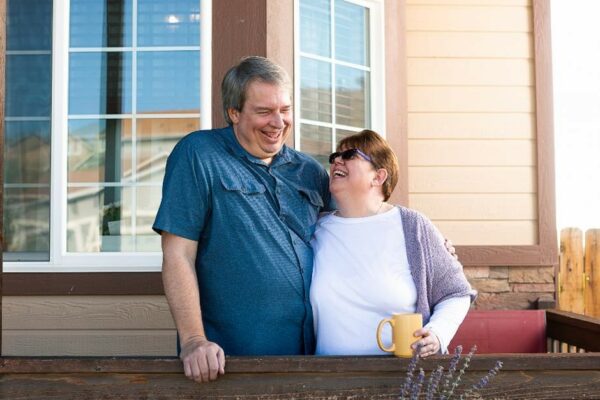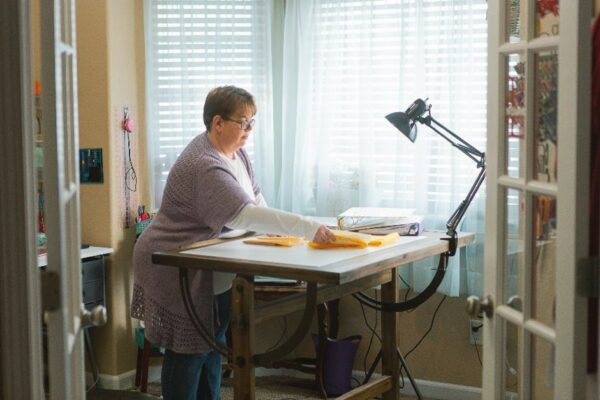Do you manage two different types of hearing devices? Cochlear™ Baha® System recipient, Michelle, shares how she manages her busy job, family and more while using a hearing aid on one ear and a Baha 6 Max Sound Processor on the other.
Set a daily routine
Part of Michelle’s daily routine is putting on her Baha 6 Max Sound Processor on one ear, and her hearing aid on the other.
“I definitely notice when I don’t wear my Baha [Sound Processor]. I’ve gotten to the point that it’s one of the first things I do. It’s the first thing I put on when I start getting ready for work and get ready to leave. I clean my abutment to make sure it’s clean and it’s dry before I put my device on. So I get my hair dry, get ready and then that’s when I go ‘okay, it’s fine’. Then I put my device and hearing aid on and it’s ‘let’s go.”
At the end of each day, Michelle, who lives in Colorado, spends time preparing her sound processor for the next day.
“I actually live in a dry climate, so I don’t have to worry about the moisture as much. But if there is really a lot of moisture in the air, I do have a dry container that I’ll take and put it in there when I need to. Other than that, I wipe it down to make sure everything’s good. I always put fresh battery as soon as I know it’s needed.”
Choose streaming to the side that lets you hear more
When she started using a hearing aid two years ago, Michelle had to figure out how to make hearing adjustments to two different hearing devices.
Currently, Bluetooth® only allows connection to one device at a time, so Michelle had to choose which hearing device app to have on her smartphone. As her natural hearing is better on her left side, she prioritizes her hearing aid app to stream to the left side.
This meant Michelle had to find a way to change her Baha 6 Max Sound Processor settings without using the Baha Smart App1 on her smartphone. Instead, she uses the app on her iPad at home. When she’s at work or elsewhere, she uses the Cochlear Wireless Phone Clip2 to make quick changes.
“It is difficult when you have two different types of devices. How do I control the volume on my device? How can I try to adjust the other one? And that’s how I’ve come up with just using the Phone Clip for my Baha Sound Processor, and I use my phone for my hearing aid.”
When Michelle needs to adjust her sound processor, she uses the Phone Clip to change the program and adjust the volume.
“I don’t even need to wear the Phone Clip. I just take it out and do what I need, kind of like the remote control.”
Ask for support at your workplace
“My office has been supportive and asked me if I need any accommodations. As of right now, the only thing I need is the ability to keep my cell phone handy or my remote out on the desk if needing to make any adjustments with my Baha [Sound Processor] or hearing aid.
“The office did have hard surface floors and the last few years carpet was added to help filter sound to make it easier to hear. If there is a need for further accommodations, they are open to them. All I need to do is ask.”
Know your tech support options
Michelle stresses the importance of knowing how to get the help you need when you need it. If she needs helps with her hearing devices, she knows where to turn.
As well as contacting Cochlear support when she has questions for her Baha 6 Max Sound Processor, she finds Apple accessibility support services helpful, using their dedicated phone number and chat service.
“Apple in America has an accessibility phone number. So if you have an issue because of your accessibilities for your iPhone®, 3 there’s a phone number, and you can contact them for help with your iPhone and your accessibility for it. So if you have a hearing aid or if you have like the Baha [Sound Processor], they can help you with those issues,” she says.
You can contact Apple support for chat and phone accessibility support in the United States and Canada.
“If something is not working right, you need to say something and do something.”
Advocate for yourself
Michelle’s daughter was born with bilateral hearing loss. This was a major “aha” moment for Michelle to start advocating for herself and be a role model for her daughter. “It doesn’t matter how you communicate, as long as you can communicate. And that was always our advocacy for my daughter,” she says.
With her daughter now planning a wedding, Michelle is happy her daughter knows what questions to ask and how to proactively manage her hearing.
“I think I did a good job. She knows the questions she needs to ask. She doesn’t just accept answers. That’s the biggest thing. She’s now 26 years old and actively manages her hearing. She will say to me: ‘Mom, they said if my hearing loss drops anymore, then I might look into Cochlear.’”
Watch Michelle talks about how the Baha 6 Max Sound Processor helps her connect to the people and activity she loves.
- The Cochlear Baha Smart App is available on App Store and Google Play. For compatibility information, visit www.cochlear.com/compatibility.
- For information regarding the compatibility of Cochlear’s Sound Processors with True Wireless devices, visit www.cochlear.com/compatibility.
- For information regarding the compatibility of Cochlear’s Sound Processors with True Wireless devices, visit www.cochlear.com/compatibility.


